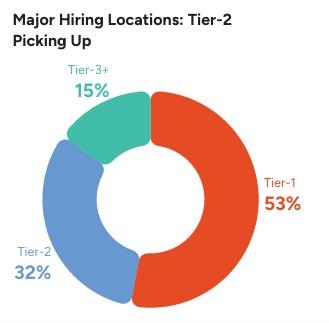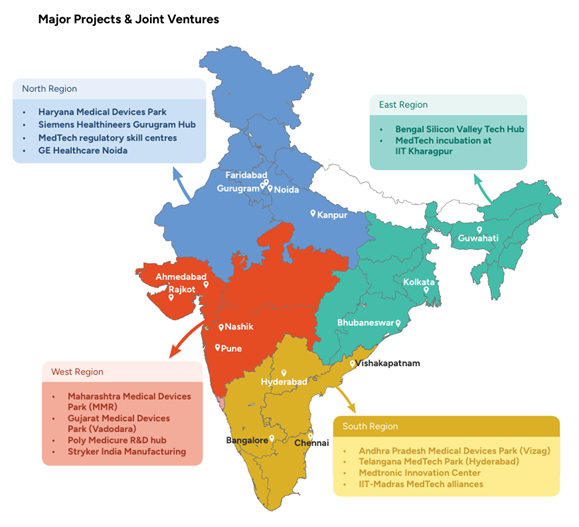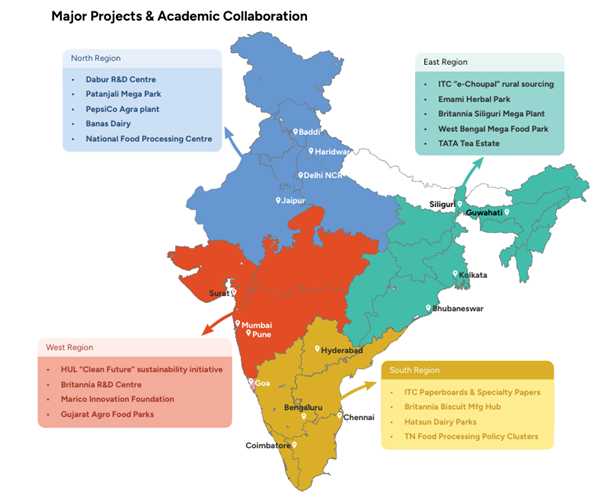
Delhi NCR, and Mumbai dominated corporate hiring conversations. But as we move into 2026, the centre of gravity is shiftingwith Tier 2 and emerging cities becoming powerful magnets for talent and investment.
According to insights from LinkedIn’s Cities on the Rise 2025 and Taggd’s India Decoding Jobs 2026: Fourth and Forward report, there has been a 40% surge in the share of Tier-2 cities hosting Global Capability Centers (GCCs), along with a 25–35% rise in overall hiring activity across Tier-2 and Tier-3+ cities. This shift signals a major rebalancing of white-collar job creation beyond traditional metros, spanning sectors like automotive, pharma, BFSI, aviation, defence, logistics, and retail.
Cities such as Visakhapatnam, Coimbatore, Indore, and Jaipur are seeing double-digit growth in hiring, driven by infrastructure expansion, hybrid work adoption, and the rise of new GCC hubs in India, as discussed in Taggd’s GCC Report 2025.
For CHROs and business leaders, this decentralization of talent offers both opportunities and challenges- from cost-optimized hiring models to building future-ready skill ecosystems in non-metro locations. Emerging sectors such as pharma, EVs, aerospace, and digital services are anchoring local economies and attracting global employers to set up new bases.
This article explores where India’s fastest-growing cities are, which sectors are hiring at the fastest pace, and how HR leaders can leverage regional talent markets to build resilient, scalable, and sustainable workforces in 2026 and beyond.
India’s Shifting Job Landscape in 2026
India enters 2026 on a strong footing with solid GDP growth, a resilient economy, and a workforce that continues to power global innovation. However, what truly defines the nation’s employment landscape today is how evenly opportunities are spreading across regions.

Traditional metros like Delhi NCR, Mumbai, and Bengaluru remain vital to India’s economic engine, but they no longer hold a monopoly on job creation. According to Taggd’s India Decoding Jobs 2026: Fourth and Forward report, Tier-2 cities now account for 32% of all planned hiring, rapidly closing the gap with Tier-1 hubs that hold 53%. Tier-3+ cities, though smaller in share, are witnessing early signs of a 15-25% surge in hiring activity, signalling the broadening of India’s talent economy.
Why metros are no longer the only job hubs
Major metropolitan areas ruled India’s job market for decades. Several factors have weakened their hold. The rising cost of living in metros has pushed companies and talent to look elsewhere. Mumbai’s office space costs four times more per square foot than cities like Jaipur or Indore.
The metros face serious infrastructure challenges too. Bangalore’s workers spend over 1.5 hours on average getting to work. That’s nowhere near the 30-45 minutes people spend in Chandigarh or Bhubaneswar. Life quality has become a top concern for today’s workforce.
Remote and hybrid work models have altered the map permanently. About 65% of Indian companies now let employees work flexibly. People don’t need to be at metropolitan headquarters anymore.
The rise of Tier 2 and Tier 3 cities
Smaller cities have grabbed these opportunities through development programs. Places like Coimbatore, Vadodara, and Bhopal have built strong digital infrastructure. Their tech parks and special economic zones match metropolitan standards at much lower costs.
The Smart Cities Mission has sped up this change. The government has invested in 100 cities to improve everything from transport to utilities. These changes have created perfect conditions for businesses to expand beyond traditional centres.
These tier 2 and 3 cities give both employers and employees some great benefits:
- Housing costs 40-60% less than metros
- Quick commutes and cleaner air
- Better community life and work-life balance
- Fresh talent pools with loyal employees
- Local government support for new businesses
To cite an instance, Jaipur’s IT sector has grown 25% each year since 2022. Kochi has become a hotspot for fintech startups looking for cheaper options outside Bangalore and Mumbai.
Taggd’s India Decoding Jobs 2026 expresses
Taggd’s latest “India Decoding Jobs 2026” report reinforces this growing shift in India’s employment geography. The study, developed in partnership with CII and leading industry bodies, highlights how the country’s talent and opportunity map is expanding beyond traditional metros- creating new growth centers across Tier-2 and Tier-3 cities.
The report reveals how industry clusters have emerged in unexpected locations, driven by digital acceleration, infrastructure investments, and the rise of hybrid work models. Pune has evolved into a manufacturing and mobility powerhouse, while Ahmedabad leads in pharmaceuticals, chemicals, and advanced materials. Bhubaneswar and Kochi are shaping their identities as education, IT, and fintech innovation hubs.
The India Decoding Jobs 2026 insights also underline that different regions now demand distinct skill archetypes. While metros continue to attract deep tech and leadership talent, emerging cities are prioritising professionals who bring cross-functional agility and adaptability- traits essential for AI-enabled, hybrid workplaces.
Compensation structures have also realigned with this decentralisation. Salaries outside metros may be relatively lower in nominal terms, but the cost-of-living advantage of 30–40% allows employees to enjoy comparable or better quality of life. For employers, this means access to sustainable, loyal talent pools and reduced operational costs.
Overall, the 2026 edition positions this transformation as part of a larger talent economy movement, where India’s next phase of growth will be powered not only by technology and capital, but by the strategic redistribution of skills, jobs, and industries across new regional hubs.
Download the “India Decoding Jobs 2026: Fourth and Forward – Fuelled by Talent” report for deeper insights into how India’s workforce is evolving across cities, sectors, and skills.
Top 8 Fastest Growing Cities and Industries in India for Jobs
India’s job growth story is no longer confined to metros like Bengaluru, Mumbai, or Delhi NCR. A new wave of employment hubs is emerging across Tier-2 and Tier-3 cities- offering a powerful mix of affordability, talent availability, and business potential.
As per Taggd’s India Decoding Jobs 2026 report, Tier-2 cities have witnessed approximately 30% rise in hosting Global Capability Centres (GCCs) and a 25–35% surge in hiring activity across industries. This shift signals a major decentralization of India’s talent economy, something CHROs and business leaders must plan for while designing workforce and location strategies.
Here are the top 10 fastest-growing cities in India for jobs in 2026, based on hiring trends, emerging sectors, and workforce expansion:
| Rank | City | Key Growth Sectors | Hiring & Investment Highlights |
| 1 | Visakhapatnam | Technology, Pharmaceuticals | 50% jump in IT hiring (2025); Cognizant & TCS investing INR 1,582 Cr and INR 1,370 Cr respectively, adding ~20,000 new jobs |
| 2 | Ranchi | Smart City Development, Retail, Education | Smart City Plan across 656 acres; government initiatives to build a knowledge hub for Jharkhand and nearby states |
| 3 | Vijayawada | Logistics, Drone Technology | 687 active job openings; emerging drone tech hub with demand for UAV trainers and pilots |
| 4 | Nashik | Automobile, IT, Real Estate | 1,100 auto and 765 real estate openings; 40–45% property growth over 5 years |
| 5 | Raipur | AI, Cloud Infrastructure, Construction | Naya Raipur expansion driving 97 IT infra roles; ArthaNova investing in blockchain & AI |
| 6 | Rajkot | Manufacturing, Startups, Engineering | Ranks #26 in India’s startup ecosystem; Gujarat Industrial Policy (2020–25) fueling tech adoption |
| 7 | Agra | Industrial Manufacturing, Tourism | INR 1,046 Cr investment in 1,058-acre manufacturing clusters; 7,200+ small-scale industries |
| 8 | Madurai | IT, Textiles, Engineering | HCLTech and Bull IT Services driving IT growth; strong textile and apparel base |
| 9 | Kochi | IT/ITeS, Logistics, Maritime | Rising GCC and IT investments; part of Kerala’s digital mission |
| 10 | Coimbatore | Textiles, Manufacturing, IT Services | Growing in engineering design and IT exports; strong SME base |
1. Visakhapatnam – Tech and pharma boom
Visakhapatnam tops LinkedIn’s Cities on the Rise list and continues to be one of India’s fastest-growing job markets in 2026. Once known primarily as a port city, Vizag has rapidly evolved into a technology and pharmaceutical hub, attracting both established players and new-age startups.
In the last year alone, IT hiring in Visakhapatnam jumped by nearly 50%, surpassing growth rates in many Tier-1 metros. Tech leaders like Cognizant and TCS are setting up large-scale campuses, investing ₹1,582 crore and ₹1,370 crore, respectively — expected to generate over 20,000 new jobs across software development, analytics, and digital transformation roles.
According to Taggd’s India Decoding Jobs 2026: Fourth and Forward report, the Indian IT sector is projected to grow hiring by 10–12% this year, led by AI, cloud, and GCC expansion. This growth is no longer confined to metros; regional IT hubs like Visakhapatnam are driving workforce diversity, internship opportunities, and advanced tech upskilling. CHROs are also rethinking recruitment priorities, 75% of hiring budgets are now being channelled into AI-powered recruitment and assessment tools, reflecting a strong industry-government push toward smarter, quality-led hiring.
On the pharmaceutical front, the region is part of India’s southern pharma corridor, which includes major projects like Pharma City (Hyderabad), Eli Lilly and Company, Bharat Biotech, CCMB, NIPER-Hyderabad, and IICT. These clusters are fuelling talent pipelines in R&D, biotech, and digital health, driving India’s ambition to become a $130 billion pharmaceutical powerhouse by 2030, as highlighted in “India Decoding Jobs” 2026.

Supported by strong port logistics, affordable infrastructure, and proactive government policies, Visakhapatnam represents the future of balanced regional growth — where technology, science, and sustainability intersect to shape India’s next wave of white-collar employment.
Key Hiring Sectors:
| Sector | Hiring Focus | Major Employers | Growth Outlook (2026) |
| Information Technology | Software Development, Cloud, Data Analytics | Cognizant, TCS, Miracle Software Systems | 50% YoY growth in hiring |
| Pharmaceuticals & Biotech | R&D, Manufacturing, Quality Assurance | Dr. Reddy’s, Laurus Labs, Bharat Biotech | >10% CAGR through FY26–27 |
| Infrastructure & Logistics | Smart city and port expansion | Adani Ports, HPCL | 15–20% rise in project-based hiring |
2. Ranchi – Smart city and retail growth
Ranchi has rapidly climbed national rankings to become India’s second-best city for professional prospects, perfectly reflecting the India Decoding Jobs 2026 trend of Tier-2 cities becoming new engines of skilled talent.
Fueled by Smart City investments, infrastructure upgrades, and a push to position Ranchi as a knowledge and services hub for Eastern India, the city is attracting employers across retail, telecom, and oil & gas- three sectors highlighted in the IDJ report for strong hiring momentum.
The Ranchi Smart City Master Plan, spanning 656 acres within 5 km of the city center is unlocking large-scale opportunities across real estate, healthcare, education, and hospitality. These developments are directly translating into rising workforce demand, especially as industry–government collaboration accelerates sectoral expansion in the East.
Let’s explore the industries hiring here-
1. Oil & Gas Sector
India’s oil and gas industry is entering a high-growth phase, with national demand expected to double from 5.57 million barrels/day (FY25) to 11 million barrels/day (FY45).
This surge is boosting hiring across Eastern India, with Ranchi emerging as a key regional talent hub.
Some of the major oil & gas projects in the East impacting Ranchi hiring are-
| Project | Location | Talent Demand |
| IOCL Paradip Refinery | Odisha | Operations, logistics, plant technicians |
| Numaligarh Refinery Expansion | Assam | Engineering, safety, project execution |
| Haldia Refinery Expansion | West Bengal | Technical staff, contract workforce |
| BPCL Durgapur LPG Project | West Bengal | Quality, plant operations, project staff |
| Oil India E&P Projects | Assam | Drilling, exploration, field services |
These large-scale projects create demand for technicians, engineers, operators, HSE professionals, and logistics talent, with Ranchi serving as a strong feeder market.
2. Telecom Sector
Telecom hiring in Ranchi is rising rapidly due to major fiber and smart-city deployments. The IDJ report identifies telecom modernisation as a key driver of tech hiring in Tier-2 cities.
Key Telecom Projects Boosting Jobs
- BSNL Fiber Network Upgrades
- Jio Fiber Expansion
- RailTel Smart City Projects
Popular roles:
- Fiber technicians
- Network engineers
- Field installation teams
- IoT and Smart City support staff
These projects are directly aligned with Ranchi’s Smart City development goals, pushing demand for digital infrastructure talent.
3. Retail Sector
Retail is one of India’s fastest-growing industries, and Ranchi is becoming a major consumption hub in Jharkhand.
Retail Expansions Driving Jobs
| Brand | Region | Hiring Impact |
| Spencer’s & Big Bazaar | Kolkata Region | Frontline staff, store ops |
| DMart | Patna, Bhubaneswar | Warehouse, supply chain |
| Reliance Smart (New Formats) | Pan-India | Cashiers, store managers, omni-channel roles |
| V-Mart | Bihar & Jharkhand | Store operations, regional staff |
Demand is strong for: store executives, cashiers, sales associates, cluster leads, warehouse teams.
3. Vijayawada – Logistics and drone tech
Vijayawada is emerging as one of India’s fastest-growing cities due to its strong logistics ecosystem, rapid IT expansion, and rising drone technology industry. Its strategic location on major national corridors makes it a preferred hub for supply chain and e-commerce companies.
At the same time, HCLTech and Infosys setting up new operations has accelerated demand for tech talent across cloud, digital engineering, and support roles. The city is also becoming a national centre for UAV/drone skills, attracting employers looking for licensed pilots and trainers.
With rising job openings, lower operational costs, and steady government investment, Vijayawada is quickly turning into a high-potential Tier-2 hiring destination for both businesses and talent.
Industries Hiring in Vijayawada (2026)
| Industry | Key Roles Hiring |
| Logistics & Supply Chain | Warehouse ops, supply chain execs, fleet managers |
| Drone Technology | Drone pilots, UAV trainees, GIS analysts |
| IT & Digital Services | Developers, cloud engineers, tech support |
| E-commerce | Last-mile ops, delivery workforce |
| Manufacturing | Technicians, electricians, quality inspectors |
4. Nashik – Auto, IT, and real estate
Nashik has rapidly evolved from a mid-sized industrial town into one of India’s strongest Tier-2 growth engines—powered by automobiles, EVs, defence manufacturing, real estate, and medical device production. Its strategic location between Mumbai and Pune, combined with fast-improving infrastructure, makes it a preferred hub for both employers and talent.
1. Auto & EV Manufacturing Is Accelerating Hiring
Nashik sits at the centre of India’s western automotive belt, supported by massive regional expansions that directly boost its talent demand.
Key Auto–EV Projects Fueling Growth
- Maruti Suzuki’s Gujarat plant: Targeting 1M units by 2028–29, strengthening the entire West India supplier ecosystem.
- Tata Motors Sanand expansion: Increasing vendor and skill demand across Nashik–Aurangabad–Pune.
- Mahindra’s EV facility (Chakan): Driving new hiring in battery assembly, EV powertrain, and component manufacturing.
- Gujarat EV policy: Tax reduction to 1%, boosting investment flow into Nashik’s supplier clusters.
Result: Nashik currently reports 1,100+ open roles in the automobile sector, making it one of India’s hottest Tier-2 auto job markets.
2. Defence Manufacturing Surge Strengthens Nashik’s Position
Nashik is indirectly benefitting from the massive defence and aerospace investments across Maharashtra and Gujarat—two of India’s biggest defence corridors.
Major Defence & Aerospace Projects Nearby
- Max Aerospace: USD 903.2 million helicopter manufacturing program.
- Tembo Defence: USD 112.9 million production facility.
- L&T Armoured Systems expansion.
- Bharat Forge: New artillery & missile component units.
- Tata–Airbus C-295 aircraft assembly line: India’s first private military aircraft facility.
These projects require thousands of skilled professionals in:
- precision engineering
- avionics
- machining
- composites manufacturing
- supply-chain and logistics
Many vendors and workforce suppliers supporting these defence hubs are based in Nashik, triggering strong hiring demand.
3. Nashik’s Role in India’s Medical Device Manufacturing Boom
As per Taggd’s India Decoding Jobs 2026, India has 20 medical device clusters, with west India (Maharashtra & Gujarat) emerging as one of the top growth zones.
West India Share of Medical Device Clusters
- Maharashtra: 4 clusters (19% share)
- Gujarat: 1 cluster (5% share)
These clusters (Pune, Aurangabad, Nashik belt) are creating:
- biomedical engineering jobs
- QA/QC roles
- regulatory affairs hiring
- medical electronics & component manufacturing jobs
Nashik benefits directly due to its manufacturing base and proximity to Pune’s med-tech ecosystem.

4. Real Estate & Urban Growth Strengthening Demand
Nashik’s real estate ecosystem has grown 40–45% in the last five years, powered by:
- industrial growth
- migration from Mumbai–Pune
- logistics expansion
- affordable housing
This translates into 765+ real-estate job openings across project management, sales, construction engineering, and urban development.
5. Raipur – AI and infrastructure investments
Raipur has rapidly evolved from a traditional industrial belt into one of India’s most promising Tier-2 job destinations. With new infrastructure, expanding city limits, and a balanced mix of manufacturing and services, the city is attracting both established enterprises and fast-growing startups. Its strategic central location and the rise of Naya Raipur (Atal Nagar) have made it a preferred choice for companies looking for scalability, talent, and affordability.
Top Industries Hiring in Raipur
Raipur is seeing strong hiring across manufacturing, steel, IT/ITeS, logistics, healthcare, and retail. Its growing industrial base and emerging tech ecosystem are driving demand for both technical and service-sector talent.
1. Manufacturing, Steel & Heavy Engineering
Raipur is one of India’s largest steel and alloy production hubs, home to hundreds of mills, plants, and fabrication units. This ecosystem drives strong demand for technical roles, operations professionals, and supply chain talent across the region.
2. IT & ITeS (A Rapidly Emerging Sector)
With new IT parks and government-backed digital infrastructure, Raipur is steadily attracting software, tech support, and BPO companies. While still growing, the sector offers increasing opportunities for developers, data professionals, and technical support executives.
3. Logistics, Warehousing & E-Commerce
Its central location makes Raipur a natural logistics corridor for East–West movement. The rise of e-commerce, 3PL providers, and large warehousing facilities is creating consistent demand for operations managers, delivery leads, and supply chain executives.
4. Healthcare & Diagnostics
Raipur has emerged as a medical hub in central India, with multispecialty hospitals, diagnostic chains, and medical colleges expanding quickly. This sector offers stable roles for clinicians, nurses, medical technicians, and administrative staff.
5. Retail, FMCG & Consumer Services
From malls to hypermarkets and FMCG distributors, the retail ecosystem in Raipur has grown significantly. Companies are hiring for store operations, sales management, merchandising, and customer experience roles across the city.
Job Roles in High Demand
Mechanical and electrical engineers, IT support staff, developers, sales managers, logistics coordinators, and back-office executives are among the most sought-after roles in Raipur, driven by rapid industrial growth, expanding tech setups, and growing retail and healthcare networks.
1. Mechanical, Electrical & Production Engineers
These roles support Raipur’s vast manufacturing ecosystem—overseeing machinery, plant operations, maintenance, and production efficiency across steel, cement, and fabrication units.
2. IT Support Engineers & Full-Stack Developers
As IT and ITeS expand, companies need engineers who can manage networks, support digital operations, and build applications. These roles are becoming central to Raipur’s emerging digital workforce.
3. Sales Executives, Territory Managers & Key Account Managers
With FMCG, retail, healthcare, and manufacturing all expanding distribution, sales roles remain consistently in demand. Companies look for professionals who can manage client relationships and grow regional business.
4. Logistics Coordinators & Warehouse Supervisors
These roles ensure smooth supply chain movement managing shipments, inventory, delivery timelines, and vendor coordination for logistics and e-commerce companies.
5. HR, Admin & Back-Office Executives
As more companies set up regional offices in Raipur, support functions like HR operations, admin management, and back-office processes are growing steadily.
6. Rajkot – Manufacturing and startups
Rajkot has grown from a traditional engineering cluster into one of western India’s fastest-developing Tier-2 job destinations. Known for its strong MSME base, precision engineering units, and expanding industrial corridors, the city offers a thriving environment for skilled professionals and growing enterprises. Its proximity to major western markets and Gujarat’s business-friendly policies make Rajkot a preferred choice for companies seeking efficiency, workforce availability, and competitive costs.
Top Industries Hiring in Rajkot
Rajkot is witnessing strong hiring momentum across engineering, auto components, manufacturing, CNC machining, IT services, and export-oriented industries. The city’s robust MSME backbone and growing industrial estates are driving sustained demand for both technical and operational talent.
1. Medical Devices & Allied Manufacturing (Emerging Opportunity)
Gujarat’s Medical Devices Park in Vadodara, combined with major projects in the West such as:
- Maharashtra Medical Devices Park (MMR)
- Poly Medicure R&D Hub
- Stryker India Manufacturing
These industries have strengthened western India as a med-tech growth zone. Rajkot plays a key support role by supplying precision-engineered parts, tooling, molds, and fabrication services essential for medical device production.

2. Engineering, Auto Components & Precision Manufacturing
Rajkot is one of India’s biggest hubs for machine tools, foundries, and auto components. Thousands of MSMEs drive continuous demand for engineers, machinists, quality inspectors, and production specialists supporting domestic and global supply chains.
3. CNC / Precision Machining & Fabrication
The city’s CNC machining ecosystem ranging from small units to advanced fabrication shops supports India’s automotive, aerospace, and industrial equipment industries. This fuels steady hiring for CNC operators, programmers, and machining supervisors.
4. Textiles, Ceramics & Traditional Manufacturing
Rajkot’s long-standing textiles and ceramics industries continue to expand with modern machinery and export demand. These sectors hire production managers, design technicians, and plant operators across multiple shifts.
5. IT & IT-Enabled Services (Gradually Growing)
While still emerging, Rajkot’s IT ecosystem is growing due to new tech parks, digital businesses, and remote-service companies. This creates roles for developers, technical support staff, and digital operations teams.
6. Export & Trading Ecosystem
Being a major supplier of engineering goods to international markets, Rajkot has a strong export infrastructure. Companies are consistently hiring export coordinators, supply-chain executives, and documentation specialists.
7. Agra – Industrial clusters and tourism
Agra- long known for its heritage and tourism economy is rapidly transforming into one of North India’s most promising Tier-2 growth cities. Improved connectivity (Yamuna Expressway, Agra–Lucknow Expressway), growing industrial zones, and strong government focus on regional development have pushed Agra into a new phase of expansion across manufacturing, logistics, IT services, and retail.
Top Sectors Hiring in Agra (2026)
1. Tourism, Hospitality & Travel Services
Agra remains one of the world’s most visited tourist cities.
This drives steady demand in:
- Hotels & resorts
- Tour operations & concierge services
- Travel agencies & experience-based tourism
- Food & beverage, cafés, and quick-service outlets
- Foreign language guides
The hospitality sector hires heavily for customer service roles, front-desk executives, chefs, digital marketing for tourism brands, event coordinators, and tour experience managers.
2. Manufacturing & Industrial Jobs
Beyond monuments, Agra has strong roots in:
- Footwear manufacturing
- Leather goods
- Marble and stone handicrafts
- Auto ancillary units
- Small-scale engineering products
Roles growing in demand:
- Production supervisors
- Quality control engineers
- Machine operators
- Supply chain coordinators
- Export documentation specialists
The Agra footwear cluster alone employs thousands and is expanding as exports rise.
3. Retail, FMCG & Consumer Services
As disposable incomes rise, Agra’s retail ecosystem- malls, hypermarkets, electronics outlets, fashion stores is hiring steadily for:
- Sales executives
- Store managers
- Visual merchandisers
- Customer support associates
- Cashiers & operations staff
Retail hiring is one of the strongest contributors to Agra’s urban employment. As per Taggd’s India Decoding Jobs 2026, Agra is witnessing rapid growth of national and regional FMCG companies due to:
- Proximity to NCR
- Strong distribution access across UP
- Affordable warehousing
- High local consumption demand
Categories growing fast include packaged foods & dairy with emerging projects like PepsiCo Agra plant in Agra, personal care & home care, beverages, household essentials, etc.

4. Logistics, Warehousing & E-Commerce
Thanks to expressways and proximity to NCR, Agra has become a preferred logistics point for:
- E-commerce hub operations
- 3PL players
- Warehousing & distribution centres
Roles gaining traction:
- Warehouse supervisors
- Delivery associates
- Inventory managers
- Last-mile logistics coordinators
5. Education & Healthcare Expansion
Agra is emerging as a regional hub with:
- New private colleges
- Coaching institutes
- Multi-speciality hospitals
Hiring roles include teachers, academic counsellors, lab technicians, nurses, hospital administrators, and medical support staff.
What Makes Agra a Rising Job Market?
- Strategic location connecting NCR, Lucknow, and Gwalior
- World-class tourism economy with year-round demand
- Industrial clusters creating stable employment
- Lower cost of living compared to Tier-1 cities
- Strong infrastructure push- metro, airport expansion, expressways
8. Madurai – IT and textile innovation
Madurai is emerging as one of South India’s fastest-growing Tier-2 cities, driven by a strong academic ecosystem, rising IT presence, and rapidly expanding healthcare and manufacturing networks. With improved connectivity, a thriving MSME base, and significant government investment in industrial estates, Madurai is attracting both domestic companies and global firms exploring Tier-2 expansion.
Why Madurai Is Growing Fast
- A major education and talent hub with engineering and medical colleges feeding local industries
- Rise of IT parks and tech companies, positioning Madurai as Tamil Nadu’s next digital destination
- Expanding healthcare, diagnostics, and medical tourism ecosystem
- Growth in automotive components, textiles, rubber, and food processing
- Improved infrastructure through national highways, the airport, and upcoming industrial corridors
Industries Driving Madurai’s Growth
- IT & ITeS (fastest-growing sector)
- Healthcare, Diagnostics & Medical Tourism
- Automotive Components & Rubber Manufacturing
- Textiles & Apparel
- Food Processing & Packaging
Madurai’s blend of skilled talent, affordable operations, and expanding industrial clusters is creating strong demand for software developers, healthcare professionals, production engineers, sales executives, and plant supervisors.
Top Sectors Hiring in 2026
The story of India’s job market in 2025 goes beyond geography. New industries are creating opportunities and changing how Indians work. Growth rates in these sectors show an unprecedented need for talent.
Information Technology and Software
IT sector continues to be India’s employment powerhouse. Job opportunities will grow by 15-20% throughout 2025. Specialized tech positions show even stronger growth – AI, machine learning, data analytics, and cloud technologies jobs will increase by 30-35%. The digital world now offers specialized roles with high salaries and unique career paths. Traditional IT companies are not alone in this growth. Global Capability Centers, manufacturing, banking, healthcare, and retail will boost their IT fresher intake by 30-35% in 2025.
Pharmaceuticals and Healthcare
India has earned its title as the “Pharmacy of the World” by producing 60% of global vaccines and 20% of generic medicines. The healthcare sector has created over 7.5 million jobs. Another 6.3 million positions will open up by 2030 – showing a 12% yearly growth. The sector needs 25% more entry-level talent compared to last year, especially in telemedicine. Healthcare IT professionals are in high demand with a 31% increase.
Manufacturing and Engineering
The Production Linked Incentive scheme has helped manufacturing grow by 12-15%. Electronics, automotive, and mobile manufacturing industries lead this expansion. Engineering roles now cover everything from electronic component design to mechanical system optimization. Physical and digital product development have merged to create these new opportunities.
E-commerce and Retail
E-commerce and tech startups lead India’s hiring with an 11.3% job growth. Logistics follows at 10.8% and retail at 8.1%. The e-commerce market will grow from INR 5906.63 billion in 2024 to INR 27423.65 billion by 2030. Companies need more operations managers, digital marketers, and supply chain specialists to support this growth.
Renewable Energy and Infrastructure
The renewable energy sector grows by 20-25% each year through solar and wind projects. The International Solar Alliance plans to bring in over $1 trillion in investments by 2030. Project managers, engineers, and business development professionals will find excellent opportunities in this sector. Technical expertise is highly valued here.
Why these cities are better than metros for job seekers
Life in smaller Indian cities now offers clear advantages over traditional metros for job seekers. These up-and-coming urban centers give professionals a chance to achieve better work-life balance and steady career growth.
1. Lower cost of living and better quality of life
The numbers make a strong case for tier 2 and 3 cities. A one-bedroom apartment costs between INR 7,000-20,000 in tier 2 cities, while metro dwellers pay INR 15,000-30,000. Property buyers find prices much lower in smaller cities at INR 3,500-7,000 per square foot compared to metro rates. The savings add up quickly:
- Public transport costs around INR 1,000 monthly in tier 2 cities but jumps to INR 3,000 in metros
- Eating out costs half as much (INR 300-600 versus INR 600-1,000)
- Grocery bills run 30% less than major cities
The benefits go beyond money. Tier 2 cities have cleaner air and shorter travel times. People in Chandigarh or Bhubaneswar spend just 30-45 minutes commuting compared to Bangalore’s grueling 1.5-hour average, which leads to a better work-life balance.
2. Government incentives and smart city projects
The Smart Cities Mission has helped smaller urban areas thrive. The program completed 7,380 out of 8,075 projects, with investments reaching INR 1,47,704 crore. Small cities get additional support through the Urban Infrastructure Development Fund, which provides INR 10,000 crore yearly to upgrade basic services.
State governments sweeten the deal for businesses moving to tier 2 locations. Tamil Nadu, to name just one example, gives an extra capital subsidy of 10-25% for IT/ITeS industries in category B&C districts. This creates more jobs locally.
3. Growing startup ecosystems and local talent pools
Small cities now host 51% of India’s startups. This shift has created dynamic innovation hubs with dedicated support systems. Cities like Jodhpur show how smart investments and local expertise can turn smaller cities into centers of innovation.
Businesses in these cities benefit from lower operating costs and keep their employees longer. The Skill India Program helps by creating specialized talent pools in these areas, especially in IT, manufacturing, and retail sectors.
How to choose the best city in India for job opportunities?
Smart career moves need more than just chasing big paychecks when picking the right city. Finding the sweet spot between your skills, lifestyle, and future goals ended up being the key to success.
Match your skills with city-specific industries
Each city has its own industrial strengths. Latest research shows IT professionals will find more opportunities in Bangalore, Hyderabad, and Mumbai because of their tech company clusters. Mumbai stands out for finance roles, while Surat attracts diamond traders. Your best move is to check if your industry thrives in your target city before making the switch.
Think over salary vs. cost of living
Living costs vary widely across India. Monthly survival wages start at INR 23,400 in Himachal Pradesh and go up to INR 46,500 in Delhi, Gujarat, and Maharashtra. Today’s professionals spend 40-50% of their monthly income on EMIs and insurance premiums – this is a big deal as it means that the recommended 25-30%. Your money goes twice as far in tier-2 cities compared to metros. This creates real savings potential even with smaller paychecks.
Look at long-term career growth potential
Smart job seekers focus on cities with steady growth paths. Tier-2 and Tier-3 cities show impressive 21% year-on-year growth compared to metros at 14%. Cities like Bhubaneshwar (41%), Udaipur (44%), and Coimbatore (24.6%) lead the pack in hiring activity. Tech skills matter more than ever as AI, IoT, and automation reshape industries of all sizes.
Wrapping Up
The Indian job market looks completely different from what it was in 2020. Traditional metros no longer control all the professional opportunities. Our analysis shows cities like Visakhapatnam, Ranchi, and Vijayawada have become strong alternatives with their specialized industries and growing career options.
Numbers tell a compelling story. These emerging cities offer housing costs that are 40-60% lower, shorter commute times, and better community bonds. The Smart Cities Mission and various state incentives have created perfect conditions for businesses to set up operations away from conventional centers.
Different sectors paint an exciting picture. IT sector keeps growing at 15-20% while creating new roles in AI and data analytics. Healthcare, manufacturing, e-commerce, and renewable energy sectors provide plenty of opportunities in these upcoming cities.
This spread of jobs across cities helps both companies and workers. Businesses can tap into fresh talent pools with better retention rates. Professionals get a better work-life balance without giving up their career growth.
You should match your skills with each city’s industries before deciding to move. Look at how far your salary will go with local living costs rather than just the number on your offer letter.
India’s professional world will keep changing. Job seekers who explore beyond traditional metros and choose these emerging hotspots will be in a great position to grow their careers and enjoy a better life.
To stay ahead of recruitment and talent trends, explore Taggd’s recruitment solutions tailored for high-growth industries.
Discover more insights, data-driven hiring trends, and expert perspectives in our India Decoding Jobs 2026 report and resources hub to plan your workforce strategy with confidence.






